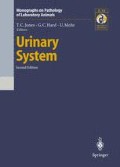Abstract
Affected kidneys are firm with finely irregular granular subcapsular surface. They appear gray to pale tan and may be slightly enlarged (Fig. 191). The cut surface is waxy and the corticomedullary junction may be difficult to discern (Thung 1957).Application of Lugol’s iodine to fresh tissue stains the glomeruli dark brown.
Access this chapter
Tax calculation will be finalised at checkout
Purchases are for personal use only
References
Brandwein SR, Skinner M, Cohen AS (1981) Isolation and characterization of spontaneously occurring amyloid fibrils in aged Syrian (golden hamsters). Fed Proc 40:789
Casey HW, Ayers KM, Robinson FR (1978) The urinary system. In: Benirschke K, Garner FM, Jones TC (eds) Pathology of laboratory animals, vol I. Springer, New York Heidelberg Berlin, p 149
Coe JE, Ross MJ (1983) Hamster female protein: a divergent acute phase protein in male and female Syrian hamsters. J Exp Med 157:1421–1433
de Beer MC, de Beer FC, Beach CM, Gonnerman W A (1993) Syrian and Armenian hamster differ in serum amyloid A gene expression. Identification of novel Syrian hamster serum amyloid A SUbtypes. J Immunol 150:5361–5370
Dodds WJ, Raymond SL, McMartin DN (1975) Atrial thrombosis and consumption coagulopathy in aged Syrian hamsters. Fed Proc 34:221
Gleiser CA, Van Hoosier GL, Sheldon WG, Read WK (1971) Amyloidosis and renal paramyloid in a closed hamster colony. Lab Anim Sci 21:197–202
McGann MA, Triplett DA (1982) Interpretation of antithrombin III activity. Lab Med 13:742–749
McMartin DN (1979) Morphologic lesions in aging Syrian hamsters. J Gerontol 34:502–511
Mezza LE, Quimby FW, Durham SK, Lewis RM (1984) Characterization of spontaneous amyloidosis of Syrian hamster using the potassium permanganate method. Lab Anim Sci 34:376–380
Niewold TA, Murphy C, Gruys E (1994) Hamster hepatic amyloid A (AA) protein is derived from a novel member of the SAA gene family. Scand J Immunol 39:229–227
Pour P, Althoff J, Salmasi SZ, Stepan K (1979) Spontaneous tumors and common diseases in three types of hamsters.JNCI 63:797–811
Rigdon RH (1974) Occurrence and association of amyloid with disease in birds and mammals including man. A review. Tex Rep Bioi Med 32:665–682
Thung PJ (1967) The relation between amyloid and ageing in comparative pathology. Gerontology 1:234–254
Editor information
Editors and Affiliations
Rights and permissions
Copyright information
© 1998 Springer-Verlag Berlin Heidelberg
About this chapter
Cite this chapter
Lewis, R.M., Mezza, L.E. (1998). Spontaneous Renal Amyloidosis, Syrian Hamster. In: Jones, T.C., Hard, G.C., Mohr, U. (eds) Urinary System. Monographs on Pathology of Laboratory Animals. Springer, Berlin, Heidelberg. https://doi.org/10.1007/978-3-642-80335-2_16
Download citation
DOI: https://doi.org/10.1007/978-3-642-80335-2_16
Publisher Name: Springer, Berlin, Heidelberg
Print ISBN: 978-3-642-80337-6
Online ISBN: 978-3-642-80335-2
eBook Packages: Springer Book Archive

